Botao Ren
Point2RBox-v2: Rethinking Point-supervised Oriented Object Detection with Spatial Layout Among Instances
Feb 07, 2025



Abstract:With the rapidly increasing demand for oriented object detection (OOD), recent research involving weakly-supervised detectors for learning OOD from point annotations has gained great attention. In this paper, we rethink this challenging task setting with the layout among instances and present Point2RBox-v2. At the core are three principles: 1) Gaussian overlap loss. It learns an upper bound for each instance by treating objects as 2D Gaussian distributions and minimizing their overlap. 2) Voronoi watershed loss. It learns a lower bound for each instance through watershed on Voronoi tessellation. 3) Consistency loss. It learns the size/rotation variation between two output sets with respect to an input image and its augmented view. Supplemented by a few devised techniques, e.g. edge loss and copy-paste, the detector is further enhanced. To our best knowledge, Point2RBox-v2 is the first approach to explore the spatial layout among instances for learning point-supervised OOD. Our solution is elegant and lightweight, yet it is expected to give a competitive performance especially in densely packed scenes: 62.61%/86.15%/34.71% on DOTA/HRSC/FAIR1M. Code is available at https://github.com/VisionXLab/point2rbox-v2.
ArtFormer: Controllable Generation of Diverse 3D Articulated Objects
Dec 10, 2024Abstract:This paper presents a novel framework for modeling and conditional generation of 3D articulated objects. Troubled by flexibility-quality tradeoffs, existing methods are often limited to using predefined structures or retrieving shapes from static datasets. To address these challenges, we parameterize an articulated object as a tree of tokens and employ a transformer to generate both the object's high-level geometry code and its kinematic relations. Subsequently, each sub-part's geometry is further decoded using a signed-distance-function (SDF) shape prior, facilitating the synthesis of high-quality 3D shapes. Our approach enables the generation of diverse objects with high-quality geometry and varying number of parts. Comprehensive experiments on conditional generation from text descriptions demonstrate the effectiveness and flexibility of our method.
PointOBB-v2: Towards Simpler, Faster, and Stronger Single Point Supervised Oriented Object Detection
Oct 10, 2024



Abstract:Single point supervised oriented object detection has gained attention and made initial progress within the community. Diverse from those approaches relying on one-shot samples or powerful pretrained models (e.g. SAM), PointOBB has shown promise due to its prior-free feature. In this paper, we propose PointOBB-v2, a simpler, faster, and stronger method to generate pseudo rotated boxes from points without relying on any other prior. Specifically, we first generate a Class Probability Map (CPM) by training the network with non-uniform positive and negative sampling. We show that the CPM is able to learn the approximate object regions and their contours. Then, Principal Component Analysis (PCA) is applied to accurately estimate the orientation and the boundary of objects. By further incorporating a separation mechanism, we resolve the confusion caused by the overlapping on the CPM, enabling its operation in high-density scenarios. Extensive comparisons demonstrate that our method achieves a training speed 15.58x faster and an accuracy improvement of 11.60%/25.15%/21.19% on the DOTA-v1.0/v1.5/v2.0 datasets compared to the previous state-of-the-art, PointOBB. This significantly advances the cutting edge of single point supervised oriented detection in the modular track.
Improving Detection in Aerial Images by Capturing Inter-Object Relationships
Apr 05, 2024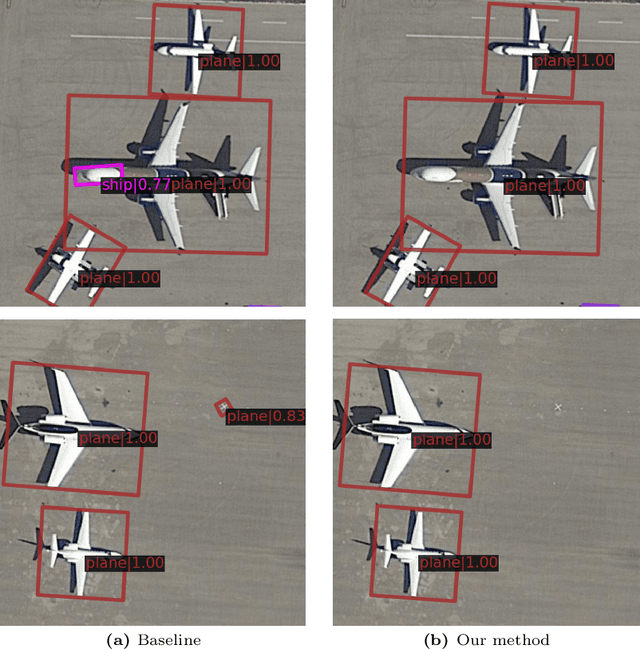
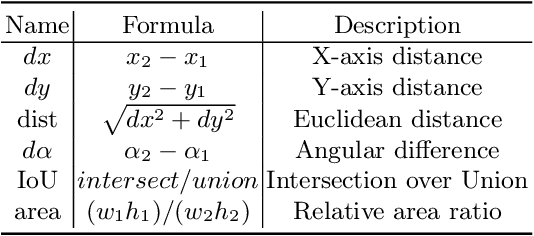
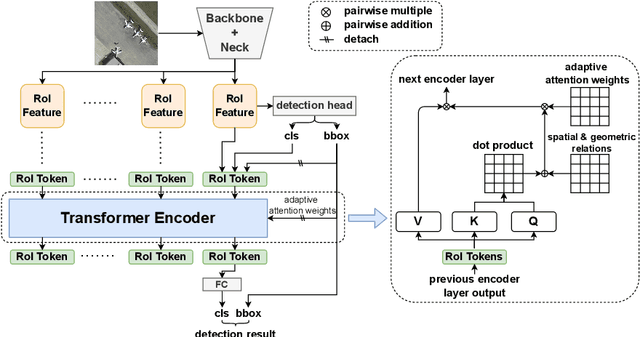

Abstract:In many image domains, the spatial distribution of objects in a scene exhibits meaningful patterns governed by their semantic relationships. In most modern detection pipelines, however, the detection proposals are processed independently, overlooking the underlying relationships between objects. In this work, we introduce a transformer-based approach to capture these inter-object relationships to refine classification and regression outcomes for detected objects. Building on two-stage detectors, we tokenize the region of interest (RoI) proposals to be processed by a transformer encoder. Specific spatial and geometric relations are incorporated into the attention weights and adaptively modulated and regularized. Experimental results demonstrate that the proposed method achieves consistent performance improvement on three benchmarks including DOTA-v1.0, DOTA-v1.5, and HRSC 2016, especially ranking first on both DOTA-v1.5 and HRSC 2016. Specifically, our new method has an increase of 1.59 mAP on DOTA-v1.0, 4.88 mAP on DOTA-v1.5, and 2.1 mAP on HRSC 2016, respectively, compared to the baselines.
Feedback RoI Features Improve Aerial Object Detection
Nov 28, 2023



Abstract:Neuroscience studies have shown that the human visual system utilizes high-level feedback information to guide lower-level perception, enabling adaptation to signals of different characteristics. In light of this, we propose Feedback multi-Level feature Extractor (Flex) to incorporate a similar mechanism for object detection. Flex refines feature selection based on image-wise and instance-level feedback information in response to image quality variation and classification uncertainty. Experimental results show that Flex offers consistent improvement to a range of existing SOTA methods on the challenging aerial object detection datasets including DOTA-v1.0, DOTA-v1.5, and HRSC2016. Although the design originates in aerial image detection, further experiments on MS COCO also reveal our module's efficacy in general detection models. Quantitative and qualitative analyses indicate that the improvements are closely related to image qualities, which match our motivation.
Improving Scene Graph Generation with Superpixel-Based Interaction Learning
Aug 04, 2023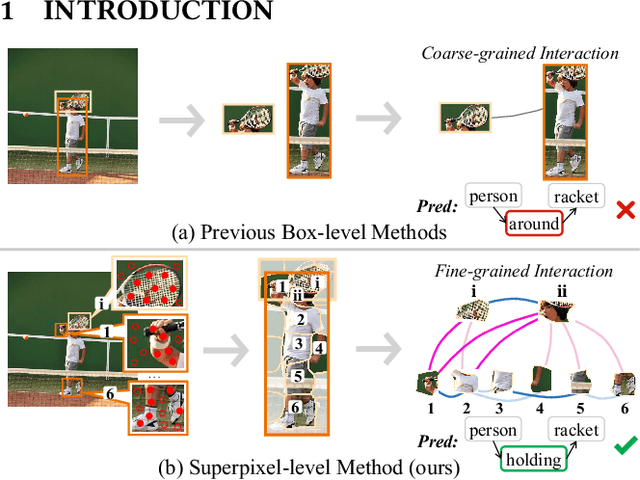
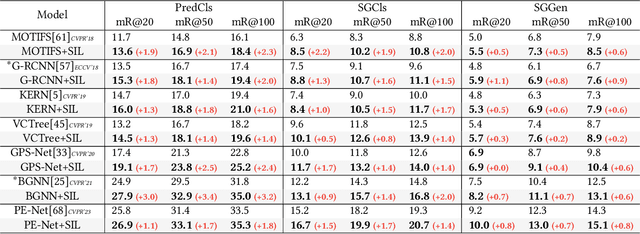


Abstract:Recent advances in Scene Graph Generation (SGG) typically model the relationships among entities utilizing box-level features from pre-defined detectors. We argue that an overlooked problem in SGG is the coarse-grained interactions between boxes, which inadequately capture contextual semantics for relationship modeling, practically limiting the development of the field. In this paper, we take the initiative to explore and propose a generic paradigm termed Superpixel-based Interaction Learning (SIL) to remedy coarse-grained interactions at the box level. It allows us to model fine-grained interactions at the superpixel level in SGG. Specifically, (i) we treat a scene as a set of points and cluster them into superpixels representing sub-regions of the scene. (ii) We explore intra-entity and cross-entity interactions among the superpixels to enrich fine-grained interactions between entities at an earlier stage. Extensive experiments on two challenging benchmarks (Visual Genome and Open Image V6) prove that our SIL enables fine-grained interaction at the superpixel level above previous box-level methods, and significantly outperforms previous state-of-the-art methods across all metrics. More encouragingly, the proposed method can be applied to boost the performance of existing box-level approaches in a plug-and-play fashion. In particular, SIL brings an average improvement of 2.0% mR (even up to 3.4%) of baselines for the PredCls task on Visual Genome, which facilitates its integration into any existing box-level method.
 Add to Chrome
Add to Chrome Add to Firefox
Add to Firefox Add to Edge
Add to Edge